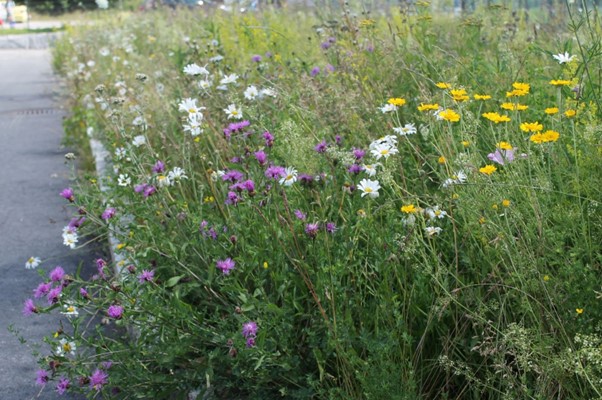A survey for residents in the Helsinki capital region is currently underway, aiming to understand residential preferences for the appearance, location, and methods of establishment of meadows in cities. You can share your views on this by participating in the survey here.
The establishment and restoration of meadows are gaining traction as tools for conserving and restoring biodiversity and as nature-based solutions for climate change mitigation in cities. This is largely because species-rich meadows can at best provide important habitat not only for plants, but also for insects dependent on them. Recent research also suggests that urban meadows present a better solution to conventional urban lawns due to their higher resilience to increasingly frequent droughts and other weather extremes.
However, we do not currently understand in sufficient detail which types of urban contexts or green spaces are perceived as suitable for meadow establishment. We know even less of how residential views and opinions concerning meadows vary across residents of diverse backgrounds. This is a crucial knowledge gap, as public support for urban environmental policies, such as meadow establishment, can present strong variation not only between different urban contexts, but also across different residents.
Furthermore, this variation has seldom been studied in the context of urban meadows – the online survey described here is among the first attempts to spatially map the so-called social acceptability of meadows in cities. Put simply, this means that the survey allows respondents to map places in the capital region where they would prefer to see meadows established. By combining this type of spatial and non-spatial social data with data on the current meadow network of the study region and the ecological performance of different types of urban meadows, research can aim to identify priority areas for meadow establishment that are ecologically defensible and enjoy high public support.
The online survey, accessible through this link, welcomes responses until late-April 2024. It takes approximately 15 minutes to take the survey. All responses will be handled anonymously and in accordance with the General Data Protection Regulation (GDPR) of the EU. For more information on how we treat your responses, please see the first page of the survey and the data protection notice that can be downloaded there. To encourage responses, a free movie ticket will be awarded to four respondents selected at random when the survey closes at the end of April 2024. If you wish to take part in this selection, please leave us your email-address at the end of the survey.
Thank you for participating!
If you have any questions concerning the survey, please contact either
Phd-student Oriol García-Antúnez, Copenhagen University, oga@ign.ku.dk (in English), or
Phd Jussi Lampinen, University of Helsinki, jussi.lampinen@helsinki.fi (in Finnish)
More information concerning the research projects underlying the survey:
The survey is a joint research effort between the research projects CO-CARBON and RESSU-GRASS.
CO-CARBON is an interdisciplinary consortium project focusing on the policies of planning, building and managing urban green infrastructure for greater benefits to carbon sequestration and storage and other ecological and social benefits. The project is funded by the Strategic Research Council (SRC) established within the Academy of Finland, and includes partners from University of Helsinki, Aalto university, Finnish Meteorological Institute, HAMK University of Applied Sciences, and University of Copenhagen.
The project RESSU-GRASS (Restoration and sustainable management of grasslands) produces new practical knowledge on the key ecological and social questions of restoration of meadows and grasslands. The project is funded by the Ella and Georg Ehrnrooth foundation and the Helsinki Institute for Sustainability Science HELSUS, and includes partners from University of Helsinki, HAMK University of Applied Sciences, and University of Copenhagen.
Starting photo: Example of an urban meadow established through sowing in the city of Espoo. The meadow includes species such as brown knapweed (Centaurea jacea), yellow chamomile (Cota tinctoria) and oxeye daisy (Leucanthemum vulgare). Photo credit: JL
